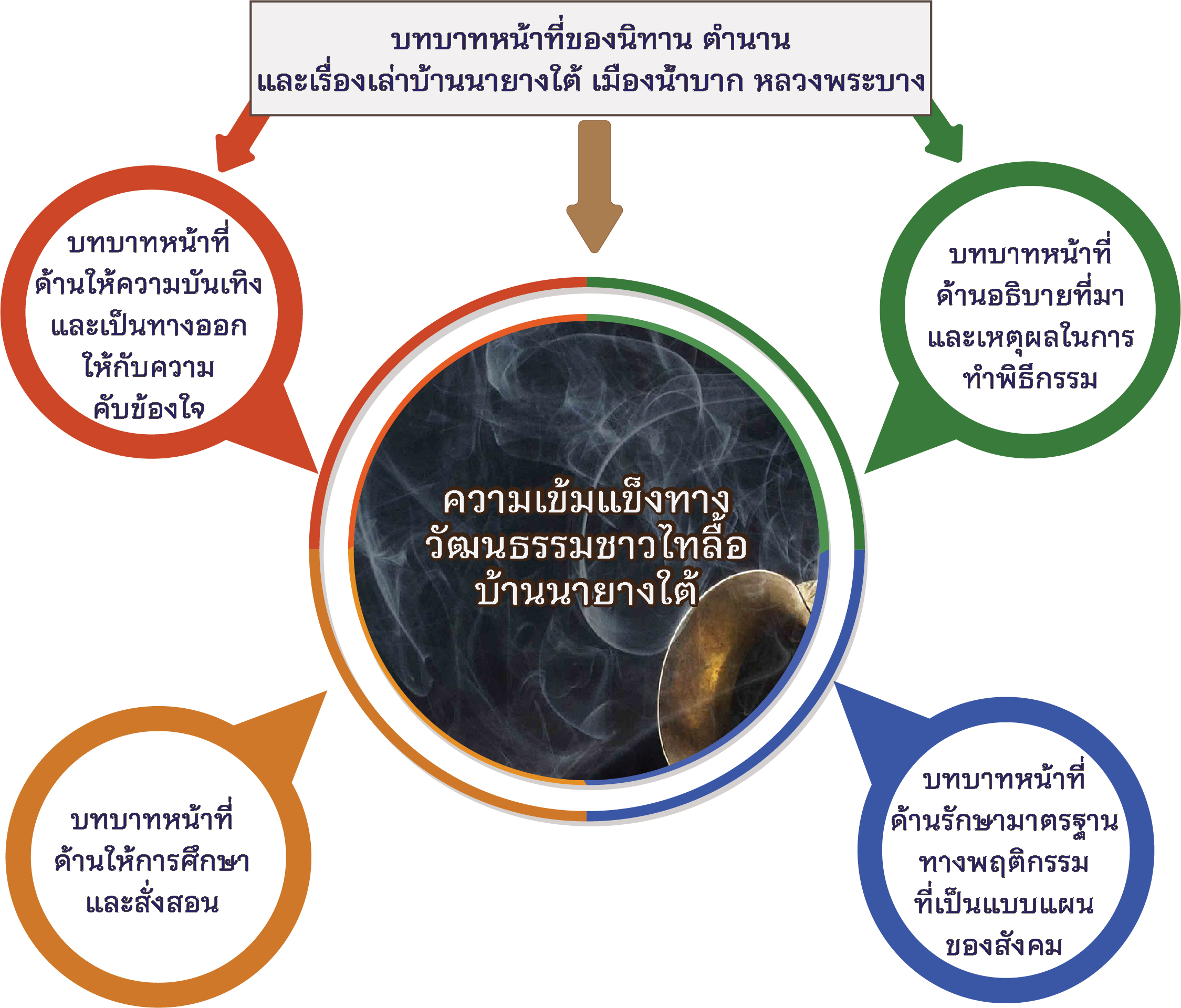The Roles and Functions of the Tales, Legends, and Narratives of the Tai Lue People in Ban Nayang Tai, Nambak District, Luang Prabang Province
Main Article Content
Abstract
The purpose of this research was to study the roles and functions of tales, legends, and narratives as understood by the Tai Lue people of Ban Nayang Tai, Muang Nga district, Luang Prabang province, Lao PDR. This qualitative research was conducted by collecting data from 30 stories, which included 9 tales, 7 legends, and 14 narratives. Data were gathered through fieldwork, interviews, and documents recorded in the community. The collected data were translated into Thai and analyzed according to the concept of roles and functions using frameworks adapted.
The results revealed that: these stories fulfill four main roles and functions. Firstly, the role of providing entertainment and serving as a means of emotional release is most commonly found in tales, as they offer enjoyment and relaxation, making them widely appreciated and memorable among the Tai Lue people. Secondly, the role of offering education and instruction is most evident in narratives, as they teach lessons about cultural values, religious beliefs, and Buddhist practices that are central to the traditions of the Tai Lue community. Thirdly, the role of maintaining and preserving social norms is most prominent in legends, as they emphasize ethical values and behaviors that align with the societal framework, contributing to the structured social fabric of the Tai Lue people. Lastly, the role of explaining the origins and reasons behind rituals and ceremonies is also most evident in legends, as they provide historical and spiritual insights related to the history of the village, ancestral reverence, or beliefs in spirits and sacred natural phenomena. These stories serve as a crucial means of guiding ritual practices and preserving the worldview of the Tai Lue community.
Article Details

This work is licensed under a Creative Commons Attribution-NonCommercial-NoDerivatives 4.0 International License.
เพื่อให้เป็นไปตามกฎหมายลิขสิทธิ์ ผู้นิพนธ์ทุกท่านต้องลงลายมือชื่อในแบบฟอร์มใบมอบลิขสิทธิ์บทความ ให้แก่วารสารฯ พร้อมกับบทความต้นฉบับที่ได้แก้ไขครั้งสุดท้าย นอกจากนี้ ผู้นิพนธ์ทุกท่านต้องยืนยันว่าบทความ ต้นฉบับที่ส่งมาตีพิมพ์นั้น ได้ส่งมาตีพิมพ์เฉพาะในวารสาร วิชาการธรรม ทรรศน์ เพียงแห่งเดียวเท่านั้น หากมีการใช้ ภาพหรือตารางของผู้นิพนธ์อื่นที่ปรากฏในสิ่งตีพิมพ์อื่นมาแล้ว ผู้นิพนธ์ต้องขออนุญาตเจ้าของลิขสิทธิ์ก่อน พร้อมทั้ง แสดงหนังสือที่ได้รับการยินยอมต่อบรรณาธิการ ก่อนที่บทความจะได้รับการตีพิมพ์References
จารุวรรณ ธรรมวัตร. (2537). วรรณกรรมท้องถิ่น กรณีอีสานล้านช้าง. มหาสารคาม: มหาวิทยาลัยมหาสารคาม.
ธวัช ปุณโณทก. (2562). วิเคราะห์วรรณกรรมท้องถิ่นเชิงเปรียบเทียบ. (พิมพ์ครั้งที่ 6). กรุงเทพฯ: มหาวิทยาลัยรามคำแหง.
พระจันทา จันทะวังโส. (2560). ประวัติบ้านนายางเหนือและนายางใต้ กลุ่มนายาง เมืองน้ำบาก แขวงหลวงพระบาง. หลวงพระบาง: ม.ป.ท.
พิทยา ว่องกุล. (2540). พลานุภาพแห่งวรรณกรรม. กรุงเทพฯ: ดอกหญ้า.
ศิราพร ณ ถลาง. (2548). ทฤษฎีคติชนวิทยา วิธีวิทยาในการวิเคราะห์ตำนาน-นิทานพื้นบ้าน. กรุงเทพฯ: โครงการเผยแพร่ผลงานทางวิชาการคณะอักษรศาสตร์ จุฬาลงกรณ์มหาวิทยาลัย.
สุกัญญาโสภี ใจกล่ำ. (2563). บทบาทหน้าที่และอุปกิเลสในนิทานพื้นบ้านภาคเหนือตอนล่าง. วารสารมนุษยศาสตร์และสังคมศาสตร์ มหาวิทยาลัยมหาสารคาม, 39(6), 115-127. https://so03.tci-thaijo.org/index.php/humsujournal/article/view/244648/168478
อมรา พงศาพิชญ์. (2541). วัฒนธรรม ศาสนา และชาติพันธุ์: วิเคราะห์สังคมไทยแนวมานุษยวิทยา. (พิมพ์ครั้งที่ 5). กรุงเทพฯ: จุฬาลงกรณ์มหาวิทยาลัย.
Bascom, W. R. (1965). Four Functions of Folklore. In by Alan Dundes (Eds.), The Study of Folklore (pp. 279–298). New Jersey: Prentice-Hall.
